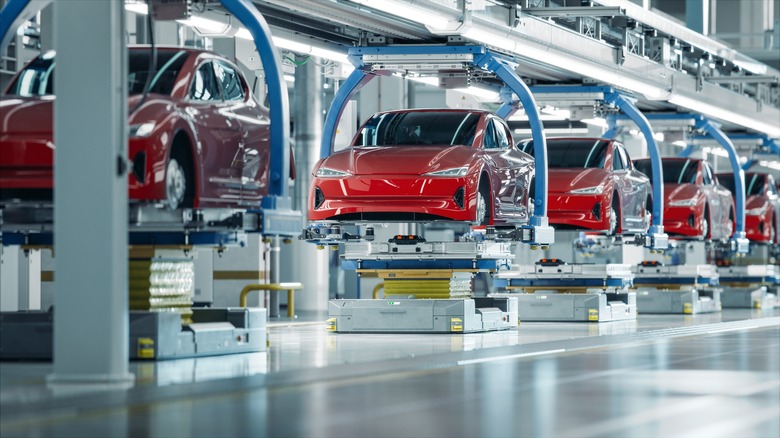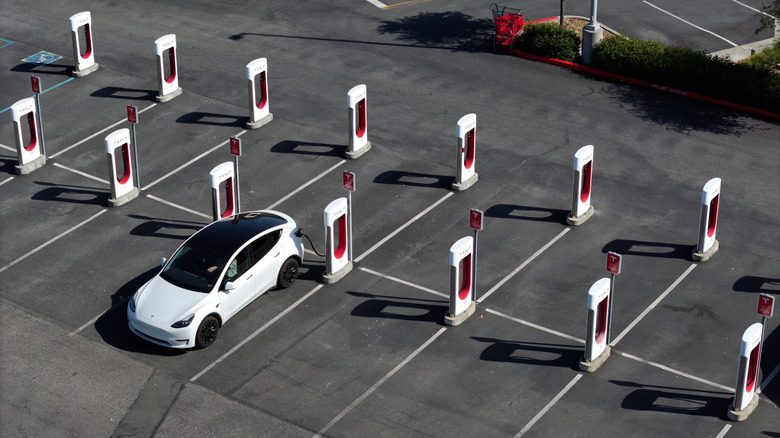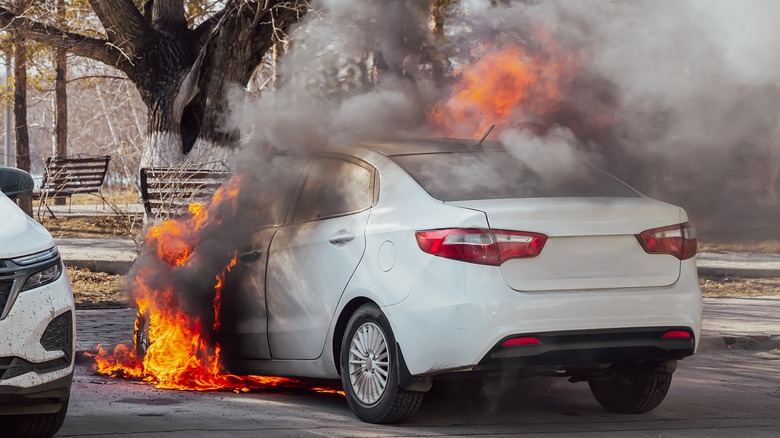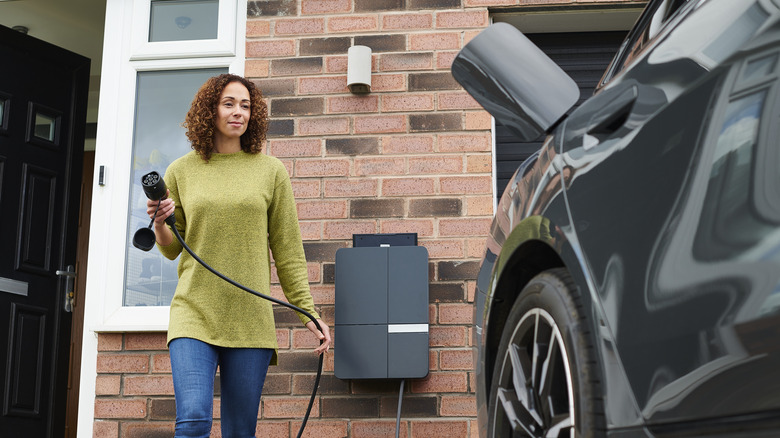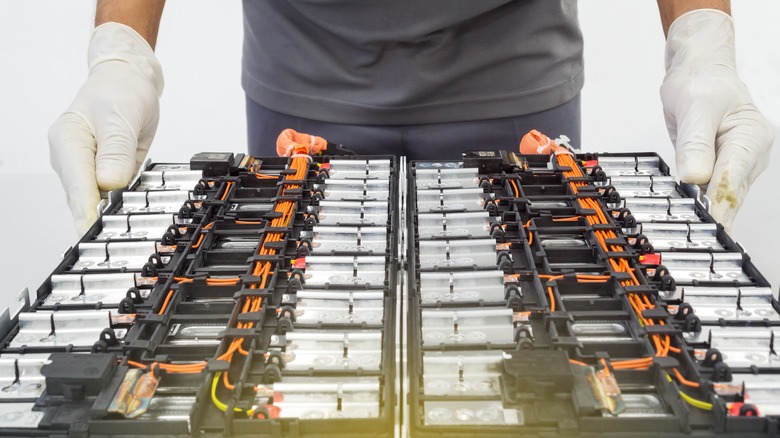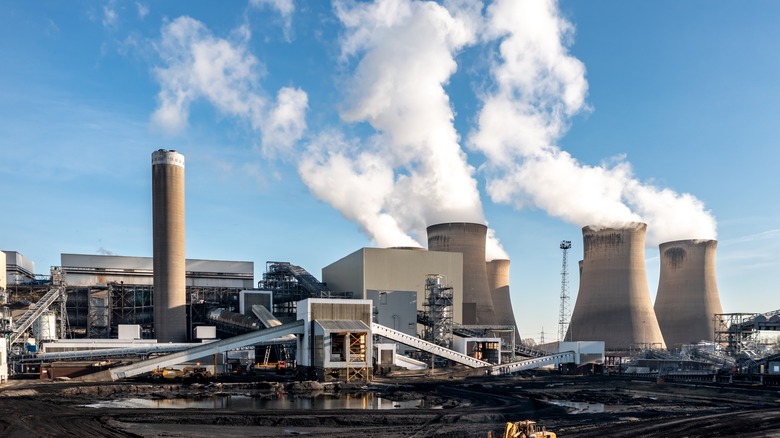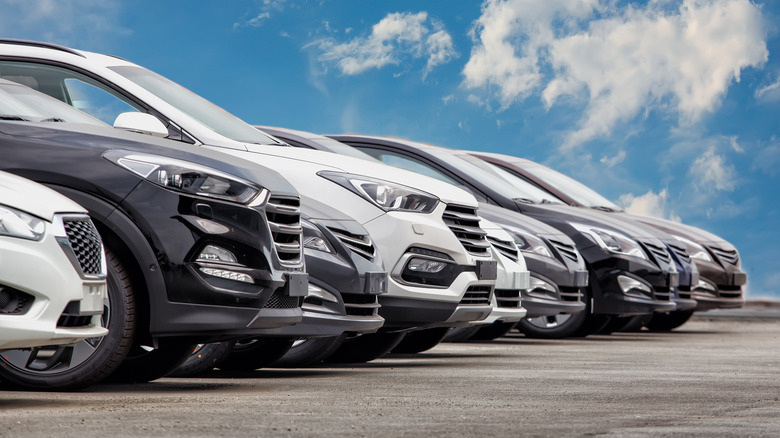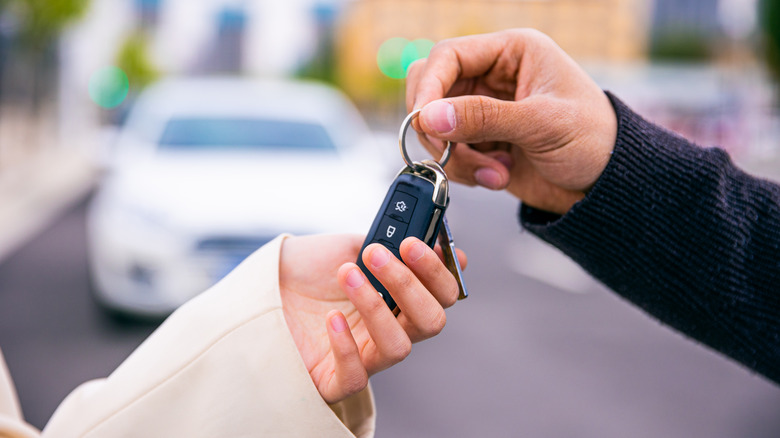Why Aren't More People Driving Electric Cars? An EV Expert Weighs In
Electric cars were once the future, but now they're the present. Virtually every major auto manufacturer has pledged to significantly cut down its production of internal combustion engine (ICE) vehicles (i.e. gas cars) or phase them out entirely before the next decade is through. POTUS is putting ever increasing pressure on manufacturers as climate change worsens, multiple states aim to require all vehicles sold to exhibit zero tailpipe emissions, and countries from Canada to the EU are putting flat-out bans on ICE sales within the coming decades in a race to catch up with China's booming EV market. All of this is great news, if not for one small catch: Car buyers have grown a bit jaded in the wake of the EV craze.
To be clear, EV sales are on the rise: A Cox Automotive report put them up year over year by 40% at the tail-end of 2023. But the overall trend is one of slowing sales. Even with how much excitement EVs have been garnering — especially as it concerns self-driving and their benefit to the environment — it would appear that "line go up," just not fast enough. To figure out what's going on, SlashGear had an exclusive a chat with Professor Laine Mears, the department chair of automotive engineering at Clemson University (the only one of its kind in the country). With his help — and a closer look at the latest data — we aim to answer why people aren't buying more EVs, and how that might change.
Cost is an issue
There are plenty of reasons more people aren't driving electric cars. "The first one is cost," Laine Mears told SlashGear. "BEVs are currently more expensive on average than internal combustion vehicles ... [and] the increased costs are more difficult to justify. This is especially true in the U.S. market, where cost is a prime consumer driver." Sadly, Mears is absolutely right. According to a 2023 CarGurus report, an EV costed approximately 28% more on average than a gas vehicle in October of that year, and that's even when you factor in things like incentives. But that's not the whole story. The cost of ownership of an EV in the first five years (they have several surprising maintenance costs) is higher than that of an ICE. The National Automobile Dealers Association (NADA) examined Kelley Blue Book's five-year cost data and found that while an ICE vehicle might run you an average of $56,962, an EV would be at least $65,202.
This isn't helped by the fact that there are other costs owners might not expect. Take, for example, "filling up" an EV — the Anderson Economic Group found that for some models, that painful visit to the pump may actually be cheaper than charging. It's not all doom and gloom, though. The U.S. federal government has a EV tax incentive that lets you claim up to $7,500 for your vehicle, and another lets you write off a part of the installation cost for an at-home charger.
There's still some uncertainty
The second reason, Laine Mears told SlashGear, is uncertainty. "Change is difficult, and transitioning from a known state of a vehicle that one can pull over and fill up on any corner to one where routing and charging need to be planned out and managed can be uncomfortable for some in the form of range anxiety and wondering where their car's next meal will come from." Range anxiety is definitely merited — there are almost 200,000 retail gas stations across the U.S., compared to approximately 64,000 EV chargers. The country is rife with dead zones, long stretches of land without charging infrastructure that occasionally make interstate travel challenging. If there's anything Americans love, it's driving, and the thought of not being able to let the road take you where it will doesn't sit right with many. And if not that, it's the paralyzing fear of getting stranded with a dead battery.
It's important to understand that range anxiety is a mostly unfounded fear. Americans drive about 38.5 miles (62 kilometers) a day, while the average EV can get at least 186.4 miles (300 kilometers), according to Forbes. Folks do most of their driving around town, after which they charge their cars overnight at home. For anything longer than that, EV owners just need to do a bit of planning.
Lack of infrastructure
Following off the previous point, Laine Mears said "there is still a great deal of work to do on the supporting electric grid infrastructure to supply the increased use once it starts." Lack of public charging consistently ranks as one of the top concerns for new car buyers, with a June 2023 Cox Automotive study finding that at least 32% are deciding against an EV based on limited charging options in their area. Recently, public EV charging stations have gotten twice as many users, even as we struggle to put charging stations in the most needed areas, like rural communities. The Washington Post reported that government investments in a charging network have cost us $7.5 billion in taxpayer dollars in return for only 7 chargers so far. News like Elon Musk gutting his entire Supercharger team certainly doesn't help, nor do predictions that our power grid can't sustain all this charging, anyway.
Mears assures us that "all is not lost. "OEMs [original equipment manufacturers], in addition to working on lower-cost offerings, are converging on the Tesla standard for charging, which would give access to an already robust national network," he told SlashGear. The White House is also now backing Tesla plug standardization as the so-called North American Charging Standard (NACS). Infrastructure always needs time to catch up with demand, and it's catching up, too. Bloomberg Green analyzed federal data and found that we've added 1,000 chargers just in the second half of 2023, or an average of 2,800 charging ports a month. Remember: It was only about a decade ago we started seeing large numbers of EVs on our roads.
EV battery fires
Laine Mears told SlashGear that EVs "can introduce new concerns such as health and safety (we usually don't want things at home catching on fire)." Lithium-ion batteries — powering our phones and electric vehicles — have a nasty tendency to explode and burst into flames when punctured. But the rash of EV battery fires in recent years has unveiled a phenomenon known as "thermal runaway," wherein an EV battery can go up in flames while sitting still and doing nothing. Manufacturers are having to recall cars with faulty batteries, lawsuits are being filed, and people are scared. These fires are extremely difficult for firefighters to control, burning for hours and requiring thousands of gallons of water to extinguish. They even sometimes reignite later after appearing put out. They set residential buildings on fire, and sometimes even ocean shipping tankers. Naturally, potential buyers are concerned for their lives and property.
Now here's the good news: EV battery fires are a lot rarer than you think. Though there's no U.S.-specific data for this yet, a Swedish Civil Contingencies Agency (MSB) report estimated that EVs made up a paltry 0.4% of all vehicle fires — 1.9% if you include hybrids. To put that statistic another way, an ICE vehicle is 29 times more likely to catch fire than an EV, according to MotorTrend. Manufacturers are working on ways to mitigate this risk — Tesla, for one, switched to safer lithium iron phosphate batteries. Future solid-state battery tech may reduce the risk even more.
Charging times
While we're on the subject of batteries, another major factor is the relatively long wait time to charge an EV. A Supercharger can fill you up in 20 minutes if you're lucky, and plugging into the wall at home easily takes all night. That's a huge step down from ICE vehicles that need all of five minutes at the pump. ICE owners can call AAA for a roadside fill-up, whereas an EV would probably need a tow. EV owners sometimes run into long lines after major events, such as the 2024 solar eclipse, which naturally take longer than a gas station even if everyone can get in and out in that ideal 20 minutes. It doesn't come as a surprise, then, that consumers don't like this state of affairs — a 2024 Deloitte study estimated that 50% of buyers take issue with charging times.
Again, most EV owners will be driving short distances around town and then charging at home. A 2024 ChargeLab survey found that 86% use the home garage outlet, and only about 60% visit their local public charging station each week. There's also evidence that some of the stories of long charging lines are exaggerated by the news and social media. All things considered, holidays and vacation high seasons are going to be busy, so EV owners should plan their travel charging with care. As we've mentioned, charging infrastructure simply needs time to catch up. It may also benefit from better tech. Ultracapacitors that charge in seconds could, someday, partially or entirely replace EV batteries.
Repairs can be tricky
Good news first: EVs generally require far less maintenance than ICE vehicles. According to the U.S. Department of Energy's Alternative Fuels Data Center (AFDC), they have fewer moving parts and generally don't require as frequent upkeep. For reference, an ICE drivetrain has over 2,000 moving parts while an EV has maybe 20. Despite this, a CCC Intelligent Solutions report found that in 2022 EV owners paid an average of $6,587 on repairs after a crash, and expanding that statistic out to all cars dropped the average to $4,215. Insurance companies, to compensate for EV's bigger expenses, often raise their premiums.
Cost isn't the only issue. The same report found that in 2022 wait times for EV repairs were 25% longer than ICE vehicles. The reason why is twofold. One, it's taking time for independent shops to make the leap to EVs since they're expensive to repair and require an entirely different skill set. Two, fixing EVs can be dangerous — there's the battery fire issue we mentioned, plus the fact that EVs expose mechanics to severe risks like electrocution.
Luckily, this problem is similar to the lack of infrastructure: It's really just a matter of time. The EV industry is a young one, and mechanics who've built their businesses around ICE for years need time to pivot. Every emergent technology slowly saturates the market before prices start to drop and service speed increases. From rental car companies to auto manufacturers, the industry predicts costs and wait times will sink as more mechanics dip their toes in doing EV repairs, and replacement parts get cheaper to make.
Environmental concerns
Professor Laine Mears told SlashGear that there are "questions around the true sustainability of BEVs (from both materials sourcing and different sources of electric energy generation)." We view EVs as the default "green" option, but they have caveats. Their greenness depends on the electricity they use (fossil fuels vs. renewables) and the materials to built them (cobalt and lithium).
The data agrees with this opinion. An Accenture report claims almost two-thirds of vehicle owners are so-called "sustainability-minded" drivers, so environmentally friendly purchasing decisions matter to them. In 2022, 46% of people believed EVs were better for the environment than ICE, but that number backslid to 38% the next year (per an Autolist survey). Though it's hard to say how much of a role environmental concerns play in one's buying decisions, it clearly does play some part. After all, the biggest allure for EV vehicles (aside from being able to plug them in as easily as a smartphone) is that you're helping to save the planet.
Environmental concerns have basis in reality, but only to an extent. MIT says that while the manufacturing process is more carbon-intensive, an EV is greener over its entire lifespan. A 2020 study published in the Nature Energy supports this notion — it found that EVs are up to three times better in terms of carbon emissions. They're also going to be using increasingly green energy sources while its ICE compatriots are burning oil till the day they die. The Environmental Protection Agency (EPA) likewise debunks the many myths around EV environmental concerns, assuring that owners can sleep soundly knowing they made the environmentally friendly choice.
Ethical concerns
Our battery-powered electronics are wonderful, but they come at a sometimes devastating price. A key component in batteries is cobalt — a mineral that's toxic to touch or breathe — and 70% of the world supply comes from the Democratic Republic of Congo (via WBUR). Siddharth Kara, a fellow at Harvard's T.H. Chan School of Public Health, told NPR that about 15-30% of mines subject workers to backbreaking, horrifically unsafe conditions and pay them less than the cost of a Starbucks coffee each day — something he called "modern-day slavery." Consequently, some have dubbed cobalt the "blood diamond of electric cars." We're all indirectly to blame for this, but some buyers may feel that their decision to buy an EV will exacerbate this already awful state of affairs.
To be fair, cobalt is used in far more than just batteries. According to data scientist Hannah Ritchie on Sustainability by Numbers, we use cobalt in catalysts, paints, and many other chemical products. Further, scientists have already figured out how to make cobalt-free batteries, and Tesla announced in 2022 that half of its cars were being produced with cobalt-free iron-phosphate batteries. And unlike some other needed materials, cobalt is easy to recycle — Statista reported in 2024 that we're already recycling approximately 68% of it. As other major companies selling battery-powered devices join the trend (such as Apple, which promised to go 100% cobalt-free by 2025), there's hope for a brighter future with more recycling and less suffering. In addition to this, the brighter future of solid-state batteries may not require so many problematic materials in the first place.
Car dealerships
Over half of Americans prefer to purchase their cars from dealerships, per 2023 data from the EY Mobility Consumer Index. As EV sales slowed and inventory kept piling up, a curious phenomenon emerged: Dealerships started to get fed up with them and even began turning them down. It's gotten to the point where they're even dissuading customers against EVs in the first place, rather than trying to clear out their inventory. This is a classic situation of high supply, low demand, and one that isn't helped when some manufacturers put you on long waitlists to buy directly from them. Take Tesla, which still has a wait time for all its models as of this writing — most notably if you are keen on the Cybertruck with all its shortages and recall woes.
Now to be clear, you won't have trouble finding an EV. A 2023 Cox Automotive report found there are almost twice as many EVs in dealerships compared to ICE vehicles, and many are sitting there for almost twice as long. Excess inventory is always a good thing for the consumer. It means no sitting endlessly on a waitlist, being able to find the model you want, and most important of all, getting some smoking deals. Eventually, dealerships will probably drop prices to free up space for new vehicles. Sure, this could make the pendulum swing in the other direction once they wash their hands of EVs, but that situation is unlikely to last long. Even though automakers have slowed production, they still have big hopes for EVs.
Resale potential
Of the many insane pandemic episodes, one of the craziest was that time when you could buy yourself a new car cheaper than a used one. Pre-and-post-pandemic, however, the outlook for EV owners aiming to rid themselves of their aging vehicle may not be quite so bright. Batteries may appear to be the culprit (they have a limited amount of charge cycles before they lose most or all of their capacity), but the larger reasons are some of those we've mentioned. According to Bloomberg, these issues include the "lack of subsidies, a desire to wait for better technology and continued shortfalls in charging infrastructures."
Now, there are government subsidies for used EVs. The IRS will let you write eligible EVs off your taxes, and if recent political efforts are any indication, we'll likely see more. The infrastructure issue, as we've discussed, is really just a matter of time. EV tech is evolving quickly in every sense, and better batteries are a pain point manufacturers are all keen on rectifying. Take solutions coming out of China, the world's leader in EV tech. Their homegrown Nio has recently innovated with an affordable way to swap out batteries in minutes — a comforting idea for used EV owners who worry about an expensive, lengthy, and invasive battery replacement.
Car culture
We Americans love our cars, but more specifically, our ICE cars. That may present a barrier to wider adoption. Pew Research Center polled the American public and discovered that at least half of people are unlikely to buy an EV. There's some politics in the mix here, too, with 73% of Republicans saying they'd be upset if we pull the plug on ICE vehicle production. Elsewhere, The Boston Globe asked its readers about ICE's farewell and got a wide variety of responses appealing to the nostalgic, experiential component of driving a gas vehicle — whether that be shifting gears or feeling the rumble of an idling engine.
In short, people are going to miss things like the thrill of popping the clutch and letting the engine roar. Gasoline car culture has been part of America for 100 years, and EVs may appear to some like a watered-down, neutered travesty. But history shows us the way forward: humans need time to adopt new technology. There may come a point in the future when ICE vehicles feel as rare and antiquated as a rotary dial telephone. The tech will get good enough that ICE vehicles will offer few benefits over EVs — and if not that, accelerating climate change may force our hand.
